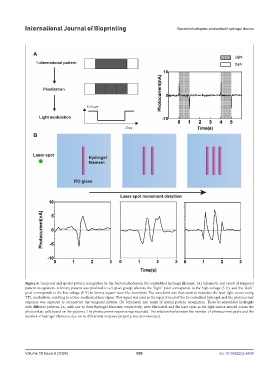Page 534 - IJB-10-6
P. 534
International Journal of Bioprinting Bacteriorhodopsin-embedded hydrogel device
Figure 6. Temporal and spatial pattern recognition by the bacteriorhodopsin (br)-embedded hydrogel filament. (A) Schematic and result of temporal
pattern recognition. A binary pattern was pixelized to a 5-pixel group, whereas the “light” pixel corresponds to the high voltage (5 V), and the “dark”
pixel corresponds to the low voltage (0 V) to form a square-wave-like waveform. The waveform was then used to modulate the laser light source using
TTL modulation, resulting in a time-modulated laser signal. This signal was used as the input stimuli of the br-embedded hydrogel, and the photocurrent
response was captured to reconstruct the temporal pattern. (B) Schematic and result of spatial pattern recognition. Three br-embedded hydrogels
with different patterns, i.e., with one to three hydrogel filaments, respectively, were fabricated, and the laser spot, as the light source, moved across the
photovoltaic cells based on the patterns. The photocurrent response was recorded. The relationship between the number of photocurrent peaks and the
number of hydrogel filaments, due to the differential response property, was demonstrated.
Volume 10 Issue 6 (2024) 526 doi: 10.36922/ijb.4454

